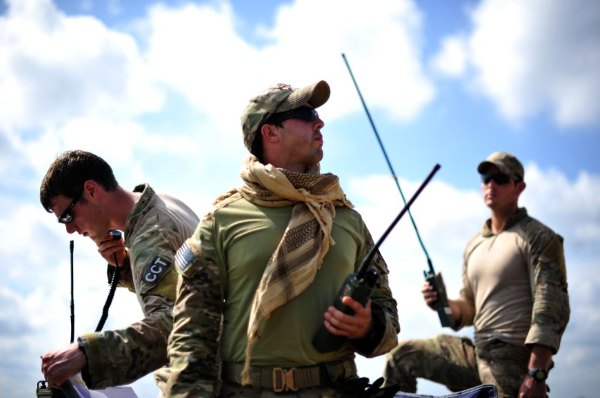United States Air Force Combat Control Teams, or singularly, Combat Controllers (CCT), are special operators assigned to Special Tactic Teams and Special Tactics Squadrons.
Air Force Combat Control Teams actually have their origins in WWII. Army parachutists would often miss the mark on their drop zone.
To combat this problem, the Department of the Army instituted Army Pathfinders.
It was the Army Pathfinder’s job to parachute in prior to any large airdrops to provide drop zone coverage.
This is where the CCT motto, “First There” originated.
In WWII, Army Pathfinders were instrumental in the success of the Normandy invasion.
In 1953, the Air Force activated Air Force Pathfinder Teams.
Later, the USAF changed the name to Air Force Combat Controllers.
CCTs serve with other Air Force Special Operations AFSCs (Tactical Air Control Party (TACP) Operators, Pararescuemen, and Special Operations Weather Technicians).
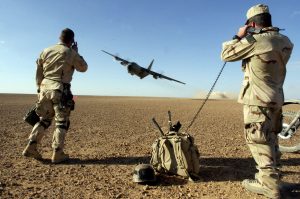
CCTs are integral to the Air Force Special Operations Command (AFSOC), the Air Force component of the United States Special Operations Command (USSOCOM).
Combat Controllers also work with Navy SEALs, Delta Force Teams, Army Rangers, and Army Special Forces as part of Joint Special Operations Command (JSOC). CCTs oftentimes work alone, as well.
Airstrike control, communications capabilities, and expert airfield seizures are but a few of the operations to which a CCT is vital.
Retired Delta Force commander-turned-author Thomas Greer (pen name, Dalton Fury) describes Combat Controllers in his 2009 book Kill Bin Laden: A Delta Force Commander’s Account of the Hunt for the World’s Most Wanted Man as such:
“The initial training “pipeline” for an Air Force Special Tactics Squadron Combat Controller costs twice as much time and sweat as does the journey to become a Navy SEAL or Delta operator.”
“Before their training is complete someone brainwashes these guys into thinking they can climb like Spiderman, swim like Tarzan, and fly like Superman — and then they have to prove they can, if they plan to graduate.”
Combat Controllers are highly specialized and must undergo extensive training in scuba, snowmobiling, and parachuting.
Additionally, CCTs are Federal Aviation Administration (FAA) certified air traffic controllers.
The Air Force Combat Controller (CCT) job is categorized as Air Force Specialty Code (AFSC) 1C2X1.
Related Article – Air Force Jobs List: A List Of All AFSCs In The Air Force
Jump To A Section
Requirements and Qualifications
To become a Combat Controller in the United States Air Force, there are specific requirements and qualifications one must meet, which include:
- High school diploma, GED with 15 college credits, or GED.
- ASVAB score of at least 49 on the General Technical portion.
- Must be between the ages of 17 and 39.
- Completion of 7.5 weeks of Basic Military Training.
- Completion of a current National Agency Check, Local Agency Checks, and Credit Check.
- Normal color vision (not colorblind) and depth perception.
- Must be eligible for a Secret security clearance.
- Successful completion of the Special Warfare Operator Enlistment Initial Fitness Test (IFT).
- A minimum score of 30 on the CCT selection model completed in the Tailored Adaptive Personality Assessment System (TAPAS).
- Physical qualification for air traffic controller duty, marine diving duty, and parachute duty.
- Physical qualification and maintenance of personal physical standards.
Related Article – Air Force Grooming Standards: Haircuts, Mustaches, Beards, And More
Training and Career Path
Prior to becoming an Air Force CCT, you must successfully complete the Air Force Basic Military Training course, commonly referred to as “Basic.”
However, if you desire to be an Air Force CCT, the USAF recommends that you prepare prior to entering the arduous CCT Pipeline.
However, to become a CCT, airmen must pass the CCT Initial Fitness Test (IFT).
The IFT consists of:
- 25-meter underwater swim – 3-minute rest
- 25-meter underwater swim – 10-minute rest
- 500-meter surface swim (freestyle, breast, sidestroke) in under 15 minutes
- 1.5 mile run in under 10:20 minutes
- 8 pull-ups within 2 minutes
- 50 sit-ups in under 2 minutes
- 40 pushups in under 2 minutes
To aid in that effort, the Air Force provides an easy-to-follow 21-Day Fitness Program for Air Force Special Operations candidates.
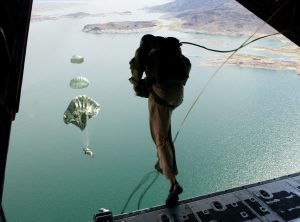
U.S. Air Force CCT jump from a C-130J Hercules aircraft. (Source: Master Sgt. Kevin J. Gruenwald, U.S. Air Force/Released)
Air Force Basic Military Training
All airmen must attend Basic Military Training (BMT) at Joint Base San Antonio (JBSA) Lackland in San Antonio, Texas.
Air Force Basic Military Training is 7.5 weeks in duration.
Skills and fundamentals taught during the rigorous weeks of Air Force BMT include a multitude of topics and skills too numerous to mention here. However, a few include:
- Physical Conditioning
- Basic Marching and Drill Movements
- Weapons Cleaning
- Law of Armed Conflict
- Flight Formation
- CPR Certification
- Code of Conduct
- M4 Rifle Training
- Air Force History and Organization
- Ethics
Please note that this list is but a basic overview of the skills taught during Basic and is not all-inclusive.
More detailed information about Air Force BMT is available in our full article here.
After Basic, the long, onerous, difficult journey to become a CCT begins in earnest.
Air Force Combat Controller Technical Training
The path to becoming a USAF CCT is not for the faint of heart, nor the weak of mind.
It is estimated that the arduous CCT training pipeline attrition rate historically waivers between 70 to 80 percent.
Training is extensive and makes USAF CCTs among the most highly trained members of the United States Armed Forces. CCTs must maintain their skills and must requalify and maintain currency in many of these skills throughout their careers.
CCT Training Pipeline
| Technical Course | Location | Duration |
|---|---|---|
| Basic Military Training | Joint Base San Antonio, Lackland AFB, TX | 7.5 Weeks |
| Special Warfare Candidate Course | Joint Base San Antonio, Lackland AFB, TX | 7 Weeks |
| Special Warfare Assessment and Selection Course | Joint Base San Antonio, Lackland AFB, TX | 4 Weeks |
| Special Warfare Pre-Dive Course | Joint Base San Antonio, Lackland AFB, TX | 4 Weeks |
| Special Warfare Combat Dive Course | Panama City, FL | 5 Weeks |
| US Army Airborne School | Fort Moore, Georgia | 3 Weeks |
| Military Free-Fall Course | Yuma Proving Ground, AZ | 4.5 Weeks |
| SERE Training | Fairchild AFB, WA | 3 Weeks |
| Air Traffic Control | Pope Army Airfield, NC | 9 Weeks |
| Combat Control Apprentice Course | Pope Army Airfield, NC | 13 Weeks |
| Special Tactics Training | Hurlburt Field, FL | 26 Weeks |
- Special Warfare Candidate Course – focuses on intensive physical condition, including running, swimming, and rucking, as well as CCT history and commandery.
- Special Warfare Assessment and Selection Course – offers you an opportunity to prove that you’re ready for the rest of the pipeline.
- Special Warfare Pre-Dive and Combat Dive Courses – includes water confidence training and physical and mental condition. You’ll also become an expert diver.
- US Army Airborne School and Military Free-Fall Course – parachuting skills required to infiltrate an objective area by static line airdrop.
- SERE – Also known as USAF Basic Survival School, teaches basic survival techniques for remote areas. Instruction includes principles, procedures, equipment, and techniques, which enable individuals to survive, regardless of climatic conditions or unfriendly environments, and return home.
- Air Traffic Control School – training toward FFA certification as an Air Traffic Controller
- Combat Control Apprentice Course – includes physical training, small unit tactics, land navigation, communications, assault zones, demolitions, fire support, and field operations including parachuting. At the completion of this course, each graduate is awarded the 3-skill level (journeymen), scarlet beret, and CCT flash.
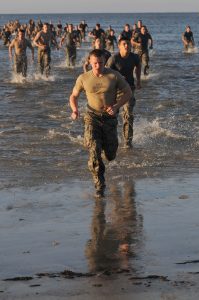
Advanced CCT Training
Newly assigned combat controllers will go on to attend Special Tactics Advanced Skills Training (AST).
Special Tactics AST is designed to produce mission-ready CCTs for the Air Force and the United States Special Operations Command.
AST Training is broken into three phases: formal training, core skills, and operational readiness.
The AST Course tests the CCT’s personal limits through demanding mental and physical training.
Special Tactics Training includes advanced weapons and demolition training, core skills, and all-terrain vehicle operation. This training awards a five-level skill rating upon graduation
Staff Sergeant Jacob Poulliot, a CCT who has been deployed to Afghanistan and Iraq, as well as participated in exercises in Korea, Australia, the Philippines, and Indonesia, explains the training of a CCT:
“We go through a very rigorous training process, which basically prepares us for any type of situation that we could encounter … It makes us better operators working in every type of environment.”
After all training is finally complete, Air Force Combat Controllers will not only be authorized to don the coveted scarlet beret and the distinctive Combat Controller Beret Flash.
CCTs will also earn the right to wear:
- Air Traffic Controller Badge
- Parachutist Badge
- Scuba Badge
- Military Free Fall Parachutist Badge
Related Article – Army Airborne School: Requirements, Length, Packing List, And More
Additional Training and Opportunities
Continued training is a part of life for a Combat Controller.
AFSC 1C271 requires experience performing or supervising duties involving reconnaissance, terminal control, and enabling tasks.
AFSC 1C291 requires experience managing operations involving reconnaissance, terminal control, and combat control-enabling tasks.
How Much Are Air Force Combat Controllers Paid?
Pay for an Air Force CCT is identical to all other enlisted personnel (in all branches), based on an airman’s rank and length of service.
| Rank | Monthly Pay (per month) |
|---|---|
| E-1 Airman Basic +4 months | $1,917 |
| E-2 Airman | $2,149 |
| E-3 Airman First Class | $2,259 |
| E-4 Senior Airman | $2,503 |
| E-5 Staff Sergeant | $2,730 |
| E-6 Technical Sergeant | $2,980 |
| E-7 Master Sergeant | $3,445 |
CCTs may also be entitled to other forms of compensation including basic allowance for housing (BAH) and base allowance for subsistence (BAS) pay if eligible.
It’s important to note that due to the large attrition rate of Combat Controllers, Air Force CCTs are often eligible for sizeable enlistment and selective re-enlistment bonuses based on the current needs of the Air Force.
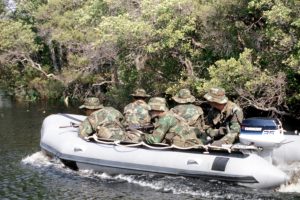
What’s Life Like as an Air Force Combat Controller?
The Air Force defines the mission of a CCT as:
“Air Force Special Operations Command’s combat controllers are battlefield Airmen assigned to special tactics squadrons. They are trained in special operations forces and certified FAA air traffic controllers. The mission of a combat controller is to deploy, undetected, into combat and hostile environments to establish assault zones or airfields, while simultaneously conducting air traffic control, fire support, command and control, direct action, counter-terrorism, foreign internal defense, humanitarian assistance and special reconnaissance in the joint arena.”
In a nutshell, a USAF Combat Controller provides command, control, communications, intelligence, surveillance, and reconnaissance (C3ISR) to assist, control, and enable the application of manned and unmanned, lethal and non-lethal airpower in all geographic and environmental conditions across the full spectrum of military operations.
This includes terminal control (air traffic control [ATC]) and targeting control of airstrikes (including close air support [CAS]), and the use of visual and electronic aids to control airheads and enable precision navigation.
In addition, CCTs provide long-range voice and data command and control and communications. They perform tactical-level surveillance and reconnaissance functions, fusing organic and remote-controlled technologies and manned platforms to build the common operating picture (COP).
The sheer scope and details of the seemingly overwhelming duties and responsibilities of a CCT, however, are far too involved and numerous to list here.
CCT Job Reviews
As stated earlier, a career as a CCT is not for the faint of heart, nor the weak of mind. CCTs are “gung-ho” professionals who take great pride in what they do. One CCT spoke of his experience on the career website glassdoor.com:

CCTs live and work by a set of standards. They call them Special Operations Forces (SOF) Truths. The SOF Truths are:
- Humans are more important than Hardware.
- Quality is better than Quantity.
- Special Operations Forces cannot be mass-produced.
- Competent Special Operations Forces cannot be created after emergencies occur.
- Most Special Operations require non-SOF assistance.
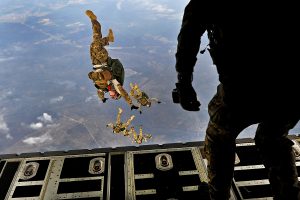
A CCT who asked to remain unnamed explains:
“One of the ideals we embrace is the SOF truth that we invest in ideas, people, and equipment — in that order. Because we have to embed with so many different SOF units, you not only have to keep up but be better since you’re the outsider. Everywhere we go, we have to prove ourselves over again. Each unit culture is different, so personality is a big thing for us during selection. You might be doing raids with Rangers one week to being underway with SEALs the next, and we need airmen who can get along with all of them when they show up.”
There are approximately 360 Combat Controllers serving in today’s Air Force. So elusive and scarce are these “silent warriors” in the 328,820-strong USAF, that many airmen have completed a 20-year career without ever having met a CCT.
Civilian Career Opportunities
Due to the peculiar duties performed by Air Force CCT, civilian opportunities are somewhat limited for CCTs looking to use all of the skills and experience learned and gained in their careers. Jobs with civilian military organizations such as DynCorp, Armed Maritime Security, and Academi are certainly options. There is also a smattering of positions for combat control instructors.
Other options also exist.
The CIA estimates that the United States is home to about a third of airports worldwide with 15,095. Former CCTs can certainly leverage their FAA certification to become air traffic controllers.
CCTs leaving the Air Force can also use their security clearance (if active) to aid in their job search.
Just as we encourage all our Air Force airmen, CCTs are strongly urged to take full advantage of their Post 9/11 GI Bill and all education opportunities afforded them during their time on active duty, such as the Air Force Tuition Assistance program and Community College of the Air Force (CCAF) / Air University.
Related Article – How To Get Into The Air Force Academy
If a career in the United States Air Force is one of the options you are currently weighing …if you are not afraid to push your body to otherworldly limits …if you want to travel and are unafraid of the dangers and perils that an uncertain world our country faces all too often, a career as an Air Force CCT might just be your path.
Not only will you perform a valuable service to your country, but you will also be among the most elite members of the United States Armed Services.
References
Air Force 21-Day Fitness Program
Official Air Force Career Webpage
Survival Evasion Resistance Escape (SERE)
Jacob Poulliot: Combat Controller
Combat Controllers > Air Force Special Operations Command
Only The Toughest Survive Combat Control Course
- Replacing Dog Tags: 6 Things You Need to Know - June 28, 2024
- Navy OAR Test Study Guide - June 24, 2024
- 10 Best Sniper Movies of all Time - June 20, 2024

